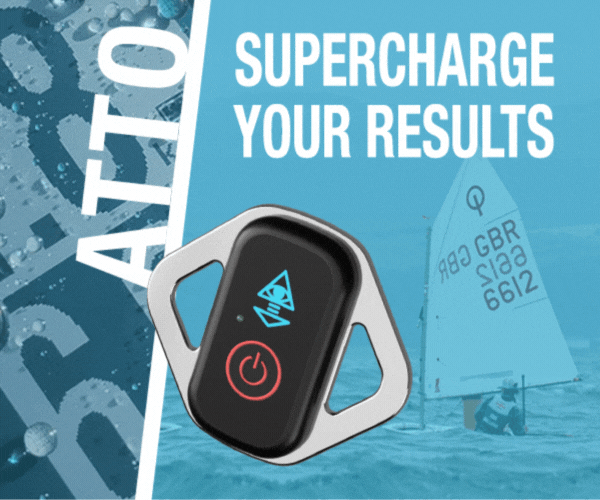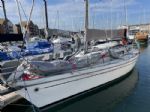
-(1)-202408140552.gif)











Boats for sale
| Rossiter Pintail Mortagne sur Gironde, near Bordeaux |
 |
| Laser 140101 Tynemouth |
 |
| Laser 28 - Excellent example of this great design Hamble le rice |
 |
List classes of boat for sale |
Downwind Gusts |
Post Reply 
|
Page <12 |
| Author | |
ColPrice2002 
Far too distracted from work 
Joined: 25 Nov 08 Location: United Kingdom Online Status: Offline Posts: 222 |
 Post Options Post Options
 Quote Quote  Reply Reply
 Topic: Downwind Gusts Topic: Downwind GustsPosted: 01 May 12 at 2:17pm |
|
Hi,
this is going to sound totally counter intuitive, but give it a try:- Assume you're on a nearly dead run (jib won't goose-wing without jib stick). When a gust hits you, the centre of effort of the mainsail is offset to the hull and the boat will try to gripe up into the wind. As the boat does this, it heels to leeward and the rudder blade lifts out of the water. The hull shape of the boat will accelerate the turning into the wind, and the boom will hit the water, locking the mainsail and you'll blow in. It's often linked with a rolling moment. In this situation 1) run to the transom - keep the bows out of the water at all costs. 2) try to keep the boom out of the water by sitting out. 3) DON'T try to turn downwind - if you do, the heeling force will diminish rapidy, the rudder will suddenly bite and you'll roll in to windward....Just keep a firm hand on the tiller. If you sail with the boat heeled to windward, then you move the centre of effort (from the mainsail) over the centre of the boat. This means that there is much less force trying to turn the boat into the wind. It feels horrible (keep a bit more plate down) but is actually more stable than trying to keep the boat upright! As a gust hits you, balance carefully, and use only small rudder movements - you will steer the boat better by changing the heel angle! Look at the Lasers, Europes etc - downwind they heel so that the mast is well off vertical. In this configuration, when a gust hits, you can actually adjust the heel by using the rudder (small amounts!). If it's at all possible, buy a jib-stick and get it in as soon as possible downwind. It really makes a lot of difference to the stability when a gust hits from astern. (based on an Enterprise with F6+ gusts - no jibstick = swim, jibstick = screamer) Colin |
|
 |
|
pondmonkey 
Really should get out more 

Joined: 12 Aug 11 Online Status: Offline Posts: 2202 |
 Post Options Post Options
 Quote Quote  Reply Reply
 Posted: 05 May 12 at 10:50am Posted: 05 May 12 at 10:50am |
running downwind is the best time to bail out the boat, eat a banana, enjoy a cigarette, have a moan with the crew about the club catering, text your wife to say you're running late (again) etc... who'd want wind shifts and tactics to get in the way of that?
|
|
 |
|
Notl 
Newbie 
Joined: 29 Jul 12 Online Status: Offline Posts: 15 |
 Post Options Post Options
 Quote Quote  Reply Reply
 Posted: 07 Aug 12 at 10:15am Posted: 07 Aug 12 at 10:15am |
|
An advanced way to deal with this is to sheet in a bit and hike more to the side.
This reduces the sail area but increases the side forces. The increased pressure on the sail should stop it from gybing. Sheeting in also holds the boom down. Bearing away on the gust is essential. Practice in strong winds is a good idea. Make sure there are rescue boats at hand. Also sailing with only the mainsail up is good. You have to rebalance the boat by adjusting the centerboard so that it is 2 thirds down upwind. This moves the pivot point aft to compensate. Does not work if you have a daggerboard. This setup makes your boat sail like a single sail single hander. Hope this gives you some ideas. |
|
 |
|
Post Reply 
|
Page <12 |
| Forum Jump | Forum Permissions  You cannot post new topics in this forum You cannot reply to topics in this forum You cannot delete your posts in this forum You cannot edit your posts in this forum You cannot create polls in this forum You cannot vote in polls in this forum |
Bulletin Board Software by Web Wiz Forums® version 9.665y
Copyright ©2001-2010 Web Wiz
Change your personal settings, or read our privacy policy
Copyright ©2001-2010 Web Wiz
Change your personal settings, or read our privacy policy











 Printable Version
Printable Version Delicious
Delicious Digg
Digg Facebook
Facebook Furl
Furl Google
Google MySpace
MySpace Newsvine
Newsvine reddit
reddit StumbleUpon
StumbleUpon Twitter
Twitter Windows Live
Windows Live Yahoo Bookmarks
Yahoo Bookmarks Topic Options
Topic Options